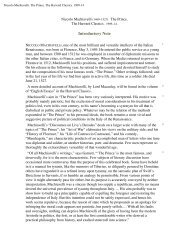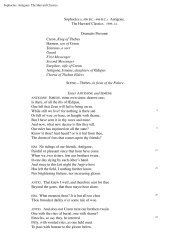Notre Dame de Paris - Bartleby.com
Notre Dame de Paris - Bartleby.com
Notre Dame de Paris - Bartleby.com
You also want an ePaper? Increase the reach of your titles
YUMPU automatically turns print PDFs into web optimized ePapers that Google loves.
<strong>de</strong>parture—the market-town of Saint-Victor, with its one-arched bridge spanning the Bièvre; its Abbey,<br />
where the epitaph of King Louis the Fat—epitaphium Ludovici Grossi—was to be seen; and its church<br />
with an octagonal spire, flanked by four belfry towers of the eleventh century (there is a similar one still<br />
to be seen at Etampes). Then there was Saint-Marceau, which already boasted three churches and a<br />
convent; then, leaving on the left the mill of the Gobelins with its white wall of enclosure, you came to<br />
the Faubourg Saint-Jacques with its beautifully carved stone cross at the cross-roads; the Church of<br />
Saint-Jacques du Haut-Pas, then a charming Gothic structure; Saint-Magloire, with a beautiful nave of<br />
the fourteenth century, which Napoleon turned into a hayloft; and <strong>Notre</strong> <strong>Dame</strong>-<strong>de</strong>s-Champs, which<br />
contained some Byzantine mosaics. Finally, after leaving in the open fields the Chartreux Monastery, a<br />
sumptuous edifice contemporary to the Palais <strong>de</strong> Justice with its gar<strong>de</strong>n divi<strong>de</strong>d off into <strong>com</strong>partments,<br />
and the <strong>de</strong>serted ruins of Vauvert, the eye turned westward and fell upon the three Roman spires of<br />
Saint-Germain-<strong>de</strong>s-Prés, in the rear of which the market-town of Saint-Germain, already quite a large<br />
parish, formed fifteen or twenty streets, the sharp steeple of Saint-Sulpice marking one of the corners of<br />
the town boundary. Close by was the square enclosure of the Foire Saint-Germain, where the fairs were<br />
held—the present market-place. Then came the abbot’s pillory, a charming little round tower, capped by<br />
a cone of lead; farther on were the tile-fields and the Rue du Four, leading to the manorial bakehouse;<br />
then the mill on its raised mound; finally, the Lazarette, a small, isolated building scarcely discernible in<br />
the distance.<br />
But what especially attracted the eye and held it long was the Abbey itself. Undoubtedly this monastery,<br />
in high repute both as a religious house and as a manor, this abbey-palace, wherein the Bishop of <strong>Paris</strong><br />
esteemed it a privilege to pass one night; with a refectory which the architect had endowed with the<br />
aspect, the beauty, and the splendid rose-window of a cathedral; its elegant Lady Chapel; its monumental<br />
dormitories, its spacious gar<strong>de</strong>ns, its portcullis, its drawbridge, its belt of crenated wall, which seemed to<br />
stamp its crested outline on the meadow beyond, its court-yards where the glint of armour mingled with<br />
the shimmer of gold-embroi<strong>de</strong>red vestments—the whole grouped and marshalled round the three high<br />
Roman towers firmly planted on a Gothic transept—all this, I say, produced a magnificent effect against<br />
the horizon.<br />
When at length, after long contemplating the University, you turned towards the right bank—the<br />
Town—the scene changed its character abruptly. Much larger than the University quarter, the Town was<br />
much less of a united whole. The first glance showed it to be divi<strong>de</strong>d into several singularly distinct<br />
areas. First, on the east, in that part of the Town which still takes its name from the “marais”—the morass<br />
into which Camulogènes led Cæsar—there was a great group of palaces extending to the water’s edge.<br />
Four huge mansions, almost contiguous—the Hôtels Jouy, Sens, Barbeau, and the Logis <strong>de</strong> la Reine<br />
mirrored in the Seine their slated roofs and slen<strong>de</strong>r turrets. These four edifices filled the space between<br />
the Rue <strong>de</strong>s Nonaindières to the Celestine Abbey, the spire of which formed a graceful relief to their line<br />
of gables and battlements. Some squalid, moss-grown hovels overhanging the water in front of these<br />
splendid buildings were not sufficient to conceal from view the beautifully ornamented corners of their<br />
faça<strong>de</strong>s, their great square stone casements, their Gothic porticoes surmounted by statues, the bold,<br />
clear-cut parapets of their walls, and all those charming architectural surprises which give Gothic art the<br />
appearance of forming her <strong>com</strong>binations afresh for each new structure. Behind these palaces ran in every<br />
direction, now cleft, palisa<strong>de</strong>d, and embattled like a cita<strong>de</strong>l, now veiled by great trees like a Carthusian<br />
monastery, the vast and multiform encircling wall of that marvellous Hôtel Saint-Pol, where the King of<br />
France had room to lodge superbly twenty-two princes of the rank of the Dauphin and the Duke of<br />
Burgundy with their retinues and their servants, not to mention the great barons, and the Emperor when










